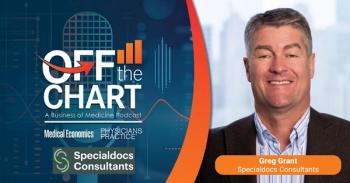
‘Addiction is a chronic medical illness that's treatable,’ and primary care physicians can help
ASAM president discusses current state of opioid crisis and how primary care could be a new avenue for physicians to connect patients to treatment.
Primary care physicians could join the front lines of combating the nation’s continuing opioid crisis.
Last year set the stage for potential greater availability of treatment for opioid use disorder (OUD). In January 2023, the U.S. Drug Enforcement Administration (DEA) published guidance stating Congress approved the elimination of the X-Waiver requirement and patient limits, making it easier for primary care physicians to prescribe
In fall 2023, The U.S.
Hurley also is medical director of the Division of Substance Abuse Prevention and Control for the Los Angeles County Department of Public Health.
Medical Economics spoke to Hurley about changes in the law and medicine, and how primary care physicians might save lives in the worst epidemic of drug overdose deaths in American history. This transcript has been edited for length and clarity.
Medical Economics: Can you provide an overview of the current state of addiction treatment and its challenges in the medical field?
Brian Hurley, MD, MBA: We're lucky to live in an era where we have more information about what is effective to treat addiction than ever before. And addiction is treatable through a broad range of medications and counseling and support, and ASAM has a number of practice guidelines that talk about medications for opioid use disorder, medications for other substance use disorders. We just released a clinical practice guideline on the
Medical Economics: By now there have been years of developing public awareness about the opioid crisis and yet national figures show that deaths are not necessarily dropping dramatically. Why is that?
Brian Hurley, MD, MBA: The reason that overdose deaths continue to climb has to do with the composition of our drug supply. At the onset of the most recent overdose epidemic, which really began with prescription opioids – but it's not specific to prescription opioids, that also includes prescription sedatives – we saw a shift. Opioid prescribing has been on the decline in the United States since 2011, so we're not seeing the same rate of prescription opioid overdose that we were seeing much earlier. We saw a shift to heroin, but most recently, we've seen a shift to fentanyl. I live in Los Angeles, fentanyl eclipsed methamphetamine as the number one drug identified in coroner cases. These are fatal overdoses. What we're seeing with the overdose crisis really is a result of the composition of the drug supply, not a result of a lot more people using or failures around the opioid prescribing. That all being said, the supply and utilization of effective treatment for opioid use disorder has also not kept pace. So, what we're seeing is an increasingly toxic drug supply and the remaining tremendous treatment gap with a number – like 80-plus percent of people with opioid use disorders specifically not receiving evidence-based treatment for their opioid use disorder. The combination of fentanyl and other high-potency opioids in our drug supply and, as a health system, us not reliably connecting people with opioid use disorder treatment, is why we haven't been able to keep pace with the overdose fight.
Medical Economics: You mentioned about increasing treatment options across the U.S. health care system, not just primary care. How could that happen or develop? Is there additional awareness needed or regulatory change?
Brian Hurley, MD, MBA: There's no segment of health care that doesn't see patients with addiction right now. Not every sector of health care necessarily holds themselves out as prepared to treat patients’ substance use disorders. Oftentimes we'll hear, oh, I don't know that this is my scope, that this is not what we do in hospital care and specialty care. But I would say in most areas of health care, we have, as close as we can, universal access to the first-line treatments for hypertension, depression, diabetes. Those exist in primary care. And in fact, there are patients in emergency rooms and hospitals and community mental health centers, the street medicine programs, that all get access to first-line treatments for common medical conditions. And addiction is a common medical condition. In recognition of this public health fact, we would say we would want to see first line treatments for addiction be available in hospital settings, its emergency rooms and on medical and surgical wards, and specialty care. I work in a community mental health center myself and I prioritize asking patients around the substances they use and offering treatments that can help support somebody's health and wellness, even if they're not necessarily ready for full, sustained abstinence. There's so much stigma around addiction that I think a lot of the social judgment that we apply related to people in their use of substances can oftentimes get in the way of recognizing that addiction is a chronic medical condition, that it is based in the brain. It's also based on people's life experiences and in the way people develop. And it's treatable, right? It's treatable with medications. It's treated with counseling, it's treatable with support. We don't expect every primary care practice to be setting up a full range of hospital residential intensive outpatient opiate treatment program services. That's not what we expect. But we think that any patient in any setting of care should be able to be asked about the substances, to be able to be started on first-line treatment connected to other resources in accordance with their needs.
Medical Economics: Lawmakers play a role in availability of medicines and money for treatment for opioid use disorder and any number of other conditions. From a policy standpoint, what would you like to see happen next at the national level or at the state level?
Brian Hurley, MD, MBA: ASAM was really happy to see the “X” waiver removed, and mandatory education for all DEA registrants. One of the things we learned from the overdose crisis is we live and work in a country where not every prescribing clinician necessarily understands everything there is to know about unsafe prescribing of controlled substances, and not every clinician feels comfortable treating people with addiction. So, having a DEA mandated set of trainings actually I think is going to be a helpful way to infuse safer prescribing practices, and infuse some of those fundamentals around treating people with addiction in a way that I think will advance advanced care. So, ASAM has been excited about those called the recent policy wins. We still need additional investments in the workforce, we still need more board-certified addiction physicians, we still need more trained addiction professionals. There’s the
Medical Economics: Our main audience is primary care physicians. What would you like to say to them, or what more would you like them to know?
Brian Hurley, MD, MBA: We're in the worst overdose crisis in American history. And while I want all of my patients to get the full range of meds and counseling and support that’s effective for their addictions, that effective addiction treatment means meeting patients where they are. One thing that every primary care physician can do is to make sure that patients have universal access to Naloxone, any patient who uses any substances or who is friends or family with anyone who uses any substances. Almost every state has good Samaritan laws around Naloxone, so don't ever miss an opportunity to prescribe Naloxone to patients because it can be covered under people's health insurance when prescribed and is a really important tool that can help reverse opioid overdose if it happens. And again, we're the worst overdose crisis in American history, more people are dying of opioid overdose than any point in American history. No one recovers if they've died. We need overdose reversal tools to be universally accessible.
That addiction is a chronic benefit illness and simply meeting with patients and talking about the substance they use, has a positive benefit. There's all research in primary care management of addiction that shows there's a positive result with just two visits where addiction is mentioned, and then a huge improvement in opioid use disorder when medications for opioid use disorder are available. Sometimes I talk to primary care colleagues and they feel overwhelmed – oh, there's so much stuff related to addiction treatment that would be needed, this is well outside of what I can do. But I would say, most of my primary care colleagues talk to patients around their diet and exercise, talk to patients about depression and other mental health conditions. They're not offering a full range of psychiatric hospitals and residential mental health, but they're doing what I call first-line feasible treatments. That's possible with addiction, first-line feasible treatments that can be well incorporated into primary care practice. Addiction is a chronic medical illness that's treatable, and primary care can oftentimes be an essential entry way for people to be able to access effective treatment.
Newsletter
Stay informed and empowered with Medical Economics enewsletter, delivering expert insights, financial strategies, practice management tips and technology trends — tailored for today’s physicians.








